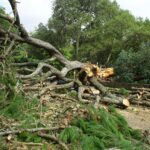At a glance
- Properly disposing of a fallen tree is crucial for safety and the environment. This ultimate guide provides step-by-step instructions on assessing the situation, removing hazards, determining disposal methods, and considering recycling options.
- Getting the most out of a fallen tree involves salvaging usable wood, utilising it for firewood or mulch, and considering the benefits of hiring a professional tree service in Melbourne for efficient removal.
- Safety considerations are paramount when disposing of a fallen tree. Wearing protective gear, using proper tools, and taking precautions during tree removal is essential to minimise the risk of accidents and injuries.
Introduction
Handling a fallen tree properly is of utmost importance, both for the sake of safety and the environment. Whether a tree has fallen due to a severe storm, disease, or other reasons, it poses potential hazards and requires immediate attention. Failing to address a fallen tree promptly and correctly can lead to further damage to property and utility lines or even endanger the lives of people in the vicinity.
One of the critical aspects of dealing with a fallen tree is ensuring its proper disposal. Improper disposal methods can result in additional environmental problems, such as pollution or the spread of pests and diseases. By understanding how to dispose of a fallen tree safely and efficiently, you can not only mitigate risks but also make the most of its potential benefits.
In this comprehensive guide, we will delve into various methods for disposing of a fallen tree. We will explore both DIY approaches and professional services in the Melbourne area. Whether you prefer to tackle the task on your own or seek the assistance of affordable tree services, this guide will provide you with the necessary insights to handle a fallen tree effectively. It is vital to approach the task with caution, using appropriate protective gear, employing the right tools and techniques, and adhering to safety guidelines throughout the process.
How to properly dispose of a fallen tree
Assess the situation:
Before taking any action, assess the situation to determine the size and condition of the fallen tree. Consider factors such as its proximity to structures, power lines, or other potential hazards.
Remove any immediate hazards:
If the fallen tree poses an immediate risk, prioritise removing any hazards to ensure safety. This may involve cutting away branches or limbs that are obstructing pathways or causing further damage.
Determine the best disposal method:
Once the immediate hazards are addressed, evaluate the best disposal method for the fallen tree. Options may include recycling, salvaging usable wood, or hiring a professional tree removal service.
Consider recycling options:
Recycling the fallen tree is an environmentally friendly option. Look for local recycling centres or organisations that accept wood waste for mulching or repurposing. This not only helps reduce waste but also contributes to sustainable practices.
Getting the most out of a fallen tree
Salvaging usable wood:
If the fallen tree is in good condition, consider salvaging the wood for various purposes. Contact local woodworkers, artisans, or woodworking organisations who may be interested in repurposing timber for furniture, crafts, or construction projects.
Utilising the tree for firewood or mulch:
Another way to maximise the fallen tree’s potential is by utilising it as firewood or mulch. Cut the tree into manageable pieces for firewood, allowing it to dry properly before use. Alternatively, use a wood chipper to create mulch, which can be used for landscaping or gardening purposes.
Hiring a professional tree service:
If handling the fallen tree yourself seems overwhelming or unsafe, it’s best to hire a professional tree removal service in Melbourne. These experts have the necessary knowledge, skills, and equipment to safely remove the tree and dispose of it properly. In Melbourne, there are affordable tree services that specialise in tree removal, ensuring a hassle-free experience.
Safety considerations when disposing of a fallen tree
Wearing appropriate protective gear:
When dealing with a fallen tree, always prioritise personal safety. Wear protective gear, including gloves, safety glasses, a hard hat, and sturdy footwear, to minimise the risk of injuries.
Using proper tools and equipment:
Ensure you have the necessary tools and equipment for cutting, lifting, and moving the fallen tree. These may include chainsaws, axes, wedges, ropes, and a sturdy ladder. Use them correctly and follow the safety guidelines provided by the manufacturer.
Taking precautions during tree removal:
If you decide to remove the fallen tree yourself, take precautions to prevent accidents. Clear the area around the tree and use proper cutting techniques to avoid pinching the saw or getting it stuck.
DIY methods for disposing of a fallen tree
Cutting the tree into manageable pieces:
Start by cutting the fallen tree into manageable sections using a chainsaw. Begin with the branches and work your way to the trunk. Make clean, horizontal cuts and be mindful of your surroundings.
Using a wood chipper:
If you have access to a wood chipper, feed the branches and smaller sections of the tree into the chipper. This will reduce the wood into small wood chips that can be used for mulching or other purposes.
Composting the branches:
If you have a compost pile, consider adding smaller branches and twigs to it. As they decompose, they will enrich the compost with valuable nutrients, which can be used in your garden. This is a great way to increase soil fertility and nourish your garden.
Professional methods for disposing of a fallen tree
Hiring a certified arborist or tree removal service:
Engaging the services of a certified arborist or a reputable tree removal company is highly recommended for complex or hazardous tree removal situations. They have the expertise, experience, and equipment necessary to safely and efficiently remove the fallen tree.
Crane-assisted tree removal:
In situations where the fallen tree is large, heavy, or difficult to access, a crane-assisted removal may be required. This method involves using a crane to lift and transport the tree sections for safer and more efficient disposal.
Stump grinding and removal:
After the fallen tree is removed, you may be left with a stump in the ground. Professional tree removal services can use specialised equipment, such as stump grinders, to effectively grind the stump and remove it completely, allowing for landscaping or replanting.
Best way to handle a fallen tree
Take a look at this comprehensive understanding of the importance of hiring professionals for fallen tree handling and removal. This article elaborates on the expertise, safety considerations, and benefits of relying on experienced professionals, especially in Melbourne. Ensure the safe and efficient disposal of fallen trees by engaging in affordable tree services that prioritise customer satisfaction.
In conclusion, properly disposing of a fallen tree is essential for safety and environmental reasons. By following the steps outlined in this ultimate guide, you can ensure the safe and efficient removal of a fallen tree while maximising its potential benefits. Whether you choose to tackle the task yourself using DIY methods or prefer to hire a professional tree service in Melbourne, prioritise safety, and consider recycling options to minimise waste. Remember to wear appropriate protective gear, use proper tools and equipment, and take necessary precautions throughout the disposal process. By handling fallen trees with care, you can turn a potential hazard into an opportunity for sustainability and resourcefulness.





